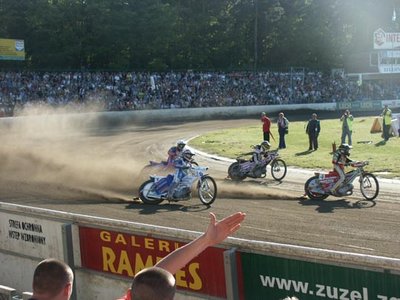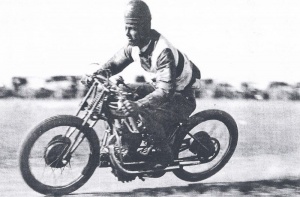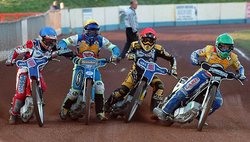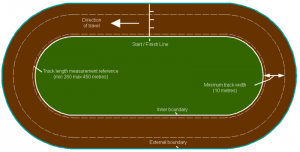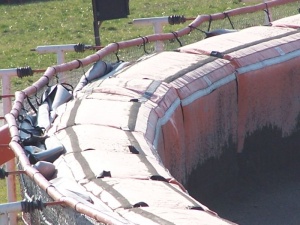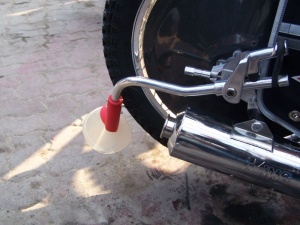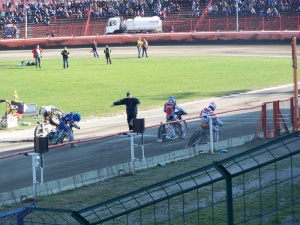Motorcycle speedway
Motorcycle speedway, normally referred to as Speedway, is a motorcycle sport that involves usually 4 and sometimes up to 6 riders competing over 4 laps of an oval circuit.
A variant of Track racing, Speedway is administered internationally by the Fédération Internationale de Motocyclisme (FIM).
Nature of the sport
Speedway racing takes place on a flat oval track usually consisting of dirt or loosely packed shale, the official definition being "a track with a top surface in granite, shale, brick granules or similar unbound material rolled in on the base ground". Competitors use this surface to slide their machines sideways (powersliding or broadsiding) into the bends using the rear wheel to scrub-off speed while still providing the drive to power the bike forward and around the bend.
Originating in New South Wales, Australia in the 1920s, there are now both domestic and international competitions in a number of countries including the Speedway World Cup whilst the highest overall scoring individual in the Speedway Grand Prix events is pronounced the Speedway world champion.
FIM regulations state that the motorcycles used must have no brakes, run on methanol, use only one gear and weigh a minimum of 77 kg. By using engine and rear wheel sprockets the gear ratio can be changed as required. Races consist of between 4 and 6 riders competing over 4 laps.
The use of methanol allows for an increased compression ratio to the engine producing higher power and resulting in higher speeds (approx 130 km/h when cornering) although the skill of Speedway lies in the overall ability of the rider to control his motorcycle when cornering and thus avoid losing places through deceleration.
The only quick way to stop a speedway bike is to pull a cut-off switch which is tied around the riders' wrists so if they come off the bike the engine will deactivate. The high compression ratio of the speedway engine also can assist in slowing down a machine if the throttle is closed the engine may also stop. Riders can stop the bike by deliberately laying down the bike on the track and this technique is used to avoid riders who fall in front of a pursuing colleague. Before cut outs were fitted an engine could be stopped by removing the plug lead from the sparking plug or shutting off the fuel supply.
There is a fence on the outside in case a rider falls off which prevent rider and bike from crashing into the fans. In the Grands prix and British and Polish elite leagues inflated air-fences are mandatory and have saved lives and reduced injury significantly since their arrival.
Speedway is presently most popular in Central and Eastern Europe, Scandinavia, the United Kingdom, and to a lesser extent these days Australia and New Zealand; there are also over a dozen tracks operating in the United States with sites in upstate New York, Indiana and California. There are also 3 tracks operating in Canada on a regular basis.
Speedway is also raced on ice with specially adapted machines.
History
The first Speedway meeting, as reported in the Maitland Mercury newspaper on 17 December 1923, took place on 15 December 1923 at Maitland Showground in the Lower Hunter Valley, New South Wales, Australia, though there is now much evidence to suggest that there were earlier meetings both in the USA and Australia. Indeed, broadsiding on small dirt tracks had been practised in America since before the First World War. A rider by the name of Don Johns was known to have done this before 1914. It was said that he would ride the entire race course wide open, throwing great showers of dirt into the air at each turn. His style of taking corners was followed in America by riders such as Albert 'Shrimp' Burns, Maldwyn Jones and Eddie Brinck well before 1923. The first meeting in the United Kingdom is generally acknowledged to have taken place at High Beech on 19 February 1928. There are, however, also claims to have held meetings in 1927 from Camberley in Surrey and Droylsden in Manchester. Despite being described as 'the first British Dirt Track meeting' at the time, the meeting at Camberley on 7 May 1927 differed in that the races were held in a clockwise direction. Races at Droylsden were held in an anti-clockwise direction and this meeting appears to have a strong claim to be the first Speedway meeting in the UK, but it is generally accepted that the sport properly arrived in the UK when Australians Billy Galloway and Keith McKay arrived with the intention of introducing Speedway to the Northern Hemisphere. Both featured in the 1928 High Beech meeting. It is probable however that the first speedway meeting in this country to feature bikes with no brakes and broadsiding round corners on loose dirt, probably the main tests of real speedway, was the second meeting held at High Beech on 9 April 1928, where Colin Watson, Alf Medcalf and 'Digger' Pugh demonstrated the art for the first time in Britain.
In the late 1920's, Australian Colin Stewart of Colac, Victoria won the prestigious Silver Gauntlet. He also achieved success at an international level, racing for Southampton in 1929 and captained the Glasgow in the Northern League in 1930 before moving to Wembley in 1931, for whom he rode in just four matches, averaging 4.00 per match. He also raced in the 1930 Scottish Championship which was won by Wembley's Harry Whitfield.
The forerunner of the World Championship, the Star Riders' Championship, was inaugurated in Great Britain in 1929 but was split in to two sections as it was felt that the British riders were not yet the equal of the Australians and Americans. Frank Arthur won the Overseas Section and Roger Frogley the British. The following year, 1930, the two sections were amalgamated and Vic Huxley proved to be the winner. Huxley was probably the best rider of these early pioneer days. He won the Star Championship once and was runner-up three times. He was also the first British Match Race champion when that competition was started in 1931.
Speed in speedway
It takes about a minute to complete four laps, each 260 to 400 metres long. For example, Leigh Adams set a record time of 59 seconds on a 342-metre track, which gives the average speed of 83 km/h (49 mph). As the limited speed on curves lowers the average, one may assume that the speed on straight sections of the track reaches 110 km/h (70 mph), or more on longer tracks. That is all achieved on a motorcycle without a gearbox.
At start, it takes between a second and two seconds for the motorcycle to reach the "curve speed" (somewhat lower than the average), which can be roughly estimated to be the equivalent of 2.5 to 3 seconds to reach 100 km/h (or "nought to sixty") The start of the race is an important aspect of the race overall, "gating" correctly can help a rider gain an initial advantage over other riders, however speed advantages can be made as a race progresses. Those riders willing to take a risk and opt for finding the grippy parts of the track rather than the race line, are sometimes rewarded with extra speed allowing them to pass other riders either on the outside or the inside.
Rules
Tracks
All tracks using for professional Speedway racing are regulated by the FIM who lay out the rules concerning construction, size and safety requirements.
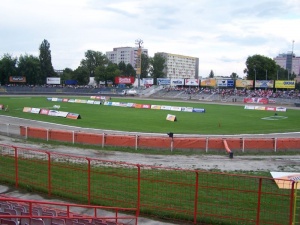
Tracks must be between 260 and 450 metres in length, this is measured at a distance of 1 metre from the inner boundary. Start lines must either be in the centre of a straight or no closer than 35 metres from a corner entrance. Additional rules govern the placement of warning systems such as lights and also the construction of the starting mechanism.
The track itself must be made up of 4 layers of grading; the topmost of which must be of shale, granite, brick granules or other loose material of which no individual piece can be over 7 mm in size. The use of asphalt, concrete and tarmac for any layer is prohibited.
The top layer must be levelled at intervals in each event to evenly re-distribute the surface, Tractors that have been modified to tow rakes are used for this. The track is also watered regularly during meetings to minimize the amount of dust lifted by motorcycles as they race.
There is a minimum track width of 10 metres, but no maximum. The minimum width is to give each rider adequate space to safely navigate the track at all points. There is no stated maximum due to the potential for tracks to be used for other sports such as Speedway Sidecar racing.
The start line and starting gate assembly is normally located halfway along one of the two straight sections of the track but some tracks have adopted alternative locations on the straight. Starting gates are usually simple mechanisms that raise two or three strands of tape to start the race. The FIM regulations also require licensed tracks to provide a garage/pit area for motorcycles as well as medical and press facilities.
Safety requirements include the use of suspended wire fences, air fences or wooden fences (for temporary tracks). The FIM recommends the use of air fences in venues if possible, these are now mandatory for tracks of teams competing in the British Elite League and Polish Ekstraliga. Neutral zones are also added for temporary tracks, giving safe run-off areas for riders without the potential to injure spectators.
The majority of FIM licensed tracks are dedicated to Speedway or other sports such as Greyhound racing. For larger events, the FIM occasionally sanctions the use of stadiums that install temporary tracks such as the Millennium Stadium in Cardiff and other Speedway Grand Prix venues.
Motorcycles
The sport of Speedway uses a unique type of motorcycle, governed by the FIM's "Track Racing Technical Rules". In the past bikes with upright engines were used in speedway racing (the name taken from the way the engine sits in the frame), but today most professional riders use laydown bikes as it is argued that they are easier to handle.
Machines used must:
- Weigh greater than 77 kg
- Use a four-stroke single cylinder engine
- Have guards fitted over moving engine parts where reasonable
- Use an additional chain guard to prevent a hand or finger/s being cut by a chain
- Have a peg (Dutch Peg) fitted to prevent a broken chain flailing and injuring a rider or a fellow competitor
- Use shatter resistant plastics where reasonable
- Be fitted with a dirt deflector
- Be fuelled by methanol
Machines used cannot:
- Use a Supercharger in any form
- Be constructed in any part from Titanium
- Use uncoated ceramic parts
- Use telemetry during a race except for timing purposes
- Use any electronic components to control the engine
- Use brakes of any form
In addition all motorcycles must have a safety cut out device fitted, this is defined as a switch that "must cut off the circuit of the electrical supply by the simple action of pulling a lanyard or a non-elastic string (with a maximum length of 30 cm) attached to the rider's right wrist."
As Speedway bikes do not use brakes, the clutch is used as a release mechanism for starts.
Races
Starting
Riders must be able to get their bikes to the start line under their own power (that is, without any external assistance and not by pushing the machine) and line up in parallel. The race is started with the raising or lowering of the tape depending on the individual mechanism used, riders then must proceed around the track in an anti-clockwise direction without both wheels illegally leaving the riding area.
Two minute time allowance
A rider who is not at the start line within a reasonable period of time is also liable to be disqualified (League matches in Great Britain allow teams to elect to start the disqualified rider fifteen metres back from the tapes or replace the disqualified rider with a team reserve).
This period of time is standardised to two minutes from a time determined by the match referee and usually indicated by a flashing or rotating orange lamp or a digital clock readout. All riders must be at the tapes under their own power before the two minutes have elapsed. Additional time between races will be allowed by, and at the discretion of, the referee if a rider has two consecutive rides, to allow the rider time to prepare.
Tapes infringements
A starting gate consisting of two or more tapes is erected across the start line, riders must situate themselves not more than 10 cm from this and not touch it at any time. These are collectively known as Tape infringements and can result in a false start being recorded and the rider disqualified (League matches in Great Britain allow teams to elect to start the disqualified rider fifteen metres back from the tapes or replace the disqualified rider with a team reserve).
Track boundaries
Marked by white lines or barriers on the inside and outside of the track, any rider who crosses this boundary with both wheels will be disqualified unless they only did so in the interest of safety or were forced to by another competitor.
Outside assistance
Once a race is underway, no rider can receive outside assistance (including push-starts) from others. Historically, pushers were allowed at the start of the race. A white line at the 30 metre mark used to designate the extent to which a push was allowed; due to safety concerns, assistance is now illegal.
The winner is the rider that completes all of the required laps first.
Scoring
Speedway operates a sliding scale for scoring (known as the 3-2-1-0 method), with points awarded to all but the final placed competitor. These points accumulate over the competition, with riders points either counting towards individual or team placings. In the event of a tie, another heat is run between those on level points. Teams can now use the TS (Tactical Substitute) rule once only for each team in the meeting if that team is 8 or more points in arrears and that rider is denoted by a Black/White helmet colour as against the 4 normal coloured helmets (Red and Blue denote home team riders whilst Green and Yellow colours denote visiting riders). If that rider remains unbeaten by either opposition rider his scored points are doubled (ie 3 = 6, 2 = 4 or 1 = 2) and also count towards the rider's C.M.A.
| Scoring for Heats with 4 riders | ||
| Place | Points | |
|---|---|---|
| 1st | 3 | |
| 2nd | 2 | |
| 3rd | 1 | |
| 4th | 0 | |
The sport also produces Calculated Match Averages (CMAs or averages) for every rider, these are calculated from the following:
CMAs scale from 3.00 to 12.00, any rider scoring above or below these values will be awarded the maximum. These averages are used in leagues such as the British Elite League to identify heat-leaders for the purposes of choosing which riders to enter for each race.
At the start of a season, a rider retains their last recorded CMA (or assessed CMA if they have never previously established one) until they have competed in six home and six away matches. A new CMA is then issued that comes into effect seven days later. These are subsequently updated on the 15th of every month from May onwards, and come into effect on the 1st of the next month.
These CMA's are used in most professional leagues and are altered or weighted depending on the league the rider gained the CMA in. A rider that has no recorded average will receive an indicative CMA for the start of the season that is assessed on their prior experience in the sport.
Competitions
| World (FIM) | Europe (UEM) | |||
|---|---|---|---|---|
| Seniors | Juniors | Seniors | Juniors | |
| Individual | WC Individual (1936-1994) SGP (since 1995) |
WC Individual U-21 (since 1977) | EC Individual (since 2001) | EC Individual U-19 (since 1998) |
| Pair | WC Pairs (1970-1993) | None | EC Pairs (since 2004) | None |
| Team | WC Team (1960-2000) SWC (since 2001) |
WC Team U-21 (since 2005) | None | EC Team U-19 (since 2008) |
World Championship
Main article Speedway World Cup|Speedway World Team Cup|Speedway World Pairs Championship
An international individual speedway championship has taken various forms since its beginnings in the 1930s. The present FIM Speedway Grand Prix championship organised by Speedway Grand Prix (IMG since 2007) has taken place since 1995. SGP uses a different scoring system, based on overall final position. The rider who has gained the most points at the end of the tournament is declared the World Champion. Nicki Pedersen (Denmark) has just won his second World Championship, the first coming in 2003 (2007). The annual British Grand Prix is currently held at the Millennium Stadium in Cardiff, Wales.
Scoring in GP events changed 2005 with riders scoring 3-2-1-0 in their races and these points being carried forward to decide the winner of each GP. At the end of the series the highest scorer will become the world champion.
World Speedway Champions include Ivan Mauger (6-time World Champion), Ove Fundin (5-time world champion), Lionel Van Praag (Inaugural World Champion in 1936), Hans Nielsen (nicknamed "The Professor", 4-times World Champion), Tony Rickardsson (6-time World Champion), Jason Crump, and Nicki Pedersen, the 2007 World Champion. The last British World Champion, in long line which includes Tommy Price, Freddie Williams (2 times), Peter Craven (2 times), Peter Collins, Michael Lee and Gary Havelock, was Mark Loram in 2000.
The Speedway World Cup event is also held each year, featuring teams from the major speedway countries, usually in a series of meetings over the space of a week in the summer. The current Champions are Poland (2007).
The Speedway World Pairs Championship was an annual speedway event held each year in different countries. Competing countries picked their top two riders to represent them. The first competition was held in 1970 and the final competition was held in 1993. From 1994 it was merged with the World Team Cup.
Domestic events
See also Speedway in the United Kingdom
Most European countries run their own domestic speedway leagues. A team speedway meeting usually features 15 heats but in a team oriented format, and each rider is scheduled to ride 4 or 5 times. In team races, there is a set order that riders will race in, although after the first 5 races, these orders are regularly adjusted. There are currently 3 levels of competition in the United Kingdom (Elite League, Premier League and Conference League) and Poland (Ekstraliga, Pierwsza Liga, Druga Liga). There are 2 leagues in Sweden. Poland is reputed to have the strongest league in the world, especially after lifting the limitation of number of foreign riders allowed per team.
Team races use traditional scoring (3-2-1-0), except in a 5-team event, where it is 4 for first and one point less for every place afterwards. In addition, a tactical rider - a substitute - is allowed for teams trailing by a certain margin to use. Or (in British speedway only) --a rider's score is doubled when nominated as a tactical ride. However, they have to beat an opponent to have their score doubled. You have to be 10 points behind to use a tactical ride although if 8 points behind you may use a tactical substitute where a chosen rider starts 15 m back.
Poland
See also Speedway in Poland
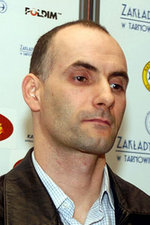
Speedway is one of the most popular sports in Poland. The Polish Extraleague has the highest average attendances for any sport in Poland. The first speedway meetings in Poland were held in the 1930's.What is the history of Polish speedway?
Speedway in Poland is governed by the Main Commission for Speedway Sport (Główna Komisja Sportu Żużlowego, GKSŻ) which is a part of the Polish Motor Union (Polski Związek Motorowy, PZM). PZM is a member of the Fédération Internationale de Motocyclisme (FIM) and the Union Européenne de Motocyclisme (UEM).
There are three championships in Poland: individual (IMP), pairs (MPPK) and team (DMP, three leagues). The Junior U-21 championships also has three championships: individual (MIMP), pairs (MMPPK) and team (MDMP). There are three leagues: Speedway Extraleague, First League and Second League. In the 2007 season, the Extraleague and First League have eight teams competing. The second League has seven teams. GKSŻ organizes the Golden Helmet, Silver Helmet (U-21) and Bronze Helmet (U-19) competitions.
The individual meetings are most popular in Poland, for example: Criterium of Polish Speedway League Aces - Mieczysław Połukard Memorial, Alfred Smoczyk Memorial and Edward Jancarz Memorial.
The Polish National team are the current World Champions. Poland has produced one Individual World Champion - Jerzy Szczakiel who won in 1973. Polish junior riders are among the best in the world. The Polish National junior team won the Under 21 World Championship in 2005 and 2006. Besides, since 2003 Polish juniors won Under 21 Individual World Championship. Polish riders have been World Champions seven times at Under 21 level.
Poland hosts the Speedway Grand Prix of Poland in the Polonia Bydgoszcz Stadium and the Speedway Grand Prix of Europe in the Olimpic Stadium in Wrocław.
Sweden
League competitions
There are three leagues in Sweden:
- Elite League (Elitserien)
- National League (Allsvenskan)
- Division One
Speedway meetings in Sweden are normally held between May and September. Swedish teams are generally known by nicknames rather than club or city names. These nicknames usually have some sort of local connection.
The Elite League was established in 1982 and has ten teams with meetings usually held on Tuesday evenings. At the end of each season the top four teams ride in the Play Offs in semi-finals and a final. The winner of the final are the Elite League champions. The team finishing bottom are relegated to the National league.
The National league has seven teams and before the introduction of the Elite league in 1982 was the top flight speedway league in Sweden. Meetings are held usually on Thursday evenings. As with the National league, the top four teams at the end of each season ride in the Play Offs in semi-finals and a final. The winner of the final are the National League champions and are promoted to the National league.
Division One is the third tier of Swedish speedway with seven teams. Meetings are usually held on Thursdays. The team finishing the seasn in first place can apply for promotion to the National league, which is subject to having suitable facilities and sufficient finances. No teams are relegated as membership of the league is by application.
Other competitions
Swedish Individual Championship This competition is for Swedish riders only. The riders are usually selected on the basis of their averages, with four riders being seeded directly to the Final. Another 36 riders are drawn into two Semi-finals, with the four lowest ranked riders in each competing in the pre-meeting runoffs. The top nine riders in each Semi-final progress to the Final which is run using a modified Grand Prix format. The winner of the Final is awarded a gold medal and becomes the Swedish Individual Champion. Riders finishing second and third are awarded silver and bronze medals.
Swedish Pairs Championship
Swedish Junior Individual Championship This competition is for Swedish riders under 21 years of age. 36 riders are drawn into two Semi-Finals, with the four lowest-ranked riders in each competing in the pre-meeting runoffs. The top seven riders in each Semi-Final progress to the Final, with the next two riders qualifying for the pre-meeting runoff. The winner of the Final is awarded a gold medal and becomes Swedish Junior Individual Champion. Riders finishing second and third are awarded silver and bronze medals respectively.
See also
- List of speedway teams in Sweden
- Speedway Grand Prix of Sweden in Eskilstuna
- Speedway Grand Prix of Scandinavia in Målilla
Italy
Introduced to Italy by occupying soldiers after World War II, the sport of Speedway currently centres around the north-east of the country. The regions of Friuli-Venezia Giulia, Trentino-Alto Adige, Lombardy and Veneto host race meetings with the latter also hosting the Speedway Grand Prix of Italy in the city of Lonigo. The most representative speedway rider from Italy is Armando Castagna, currently retired from active competition. Castagna was the only Italian professional speedway rider in the history of the sport, and qualified five times for an Individual World Final.
Denmark
Speedway in Denmark is administrated by the Danmarks Motor Union (DMU). The sport was introduced into Denmark in the 1970s. Notable Danish speedway riders include - Nicki Pedersen, Bjarne Pedersen and Hans Nørgaard Andersen. Former rider, Ole Olsen won the World Championship four times. His victories greatly helped popularise the sport in Denmark. Olsen is currently a FIM Speedway Grand Prix race director.
League competitions
There are three leagues in Denmark.:
- Danish League (Dansk Speedway Liga)
- Division One
- Division Two
Speedway meetings in Denmark are normally held between April and September.
Danish League (Dansk Speedway Liga) has six teams with meetings usually held on Wednesday evenings. At the end of each season the top four teams ride in the Play Offs in semi-finals and a final. The winner of the final are the Elite League champions. There is no promotion or relegation in Danish speedway. Membership of the Danish League is by application only.
At the end of each season the top five teams in the Danish League compete in the Danish Super Cup'; an end-of-season competition, held as a single event. It is hosted by the winning team from the previous season.
Both Division One and Division Two are the second and third tier and are mostly for amateur riders. Meetings are usually held on Saturdays with a mid summer break. Division One can have a maximum of eight teams, with the remaining teams riding in Division Two. Meetings are staged using a four-team format. In principle, the team finishing bottom of Division One is relegated and replaced by the top team in Division Two as long as their parent club does not already have a team in Division One. However, this does not always happen for financial or other reasons. There is also no promotion and relegation if the bottom team in Division One and the top team in Division Two are from the same club.
Other competitions
Danish Individual Championship This competition is for riders holding a Danish passport and a valid DMU licence. Riders must submit their entries at least four weeks before the first meeting of the competition.
Any riders who competed in the Speedway Grand Prix or World Championship Qualifying rounds during the previous season are seeded directly to the Final. The DMU may also seed other riders directly to the Final at their discretion. Either one or two Semi-Finals are staged depending on the number of riders entering the competition (excluding the seeded riders who go straight through to the Final). Riders are selected for these rounds according to the previous season's Danish averages.If one Semi-Final is held, the highest-placed riders (plus two reserves) qualify the Final. If two Semi-Finals are held, the highest-placed riders (plus one reserve) from each meeting qualify for the Final.
The winner of the Final is awarded a gold medal and declared Danish Individual Champion. The riders finishing second and third are awarded silver and bronze medals respectively. The final classification also determines which riders qualify for the World Individual Speedway Championship.
Danish Junior Individual Championship This competition is for riders holding a Danish passport, a valid DMU licence, and who are under 21 years of age on 1 January in the year of the competition. Riders wishing to compete must submit their entries at least four weeks before the first meeting of the competition. If there are 72 or more entries, four Quarter-Finals are staged. If there are at between 54 and 71 entries, three Quarter-Finals are staged. If there are less than 54 entries, two Semi-Finals are held. Riders are selected for these rounds according to the previous season's averages in Danish matches only.
When four Quarter-Finals are staged, the top eight riders (plus one reserve) in each progress to the Semi-Finals. When three Quarter-Finals are staged, the top ten riders (plus two reserves) from one round, and the top eleven riders (plus one reserve) from each of the other rounds, progress to the Semi-Finals. The top eight riders (plus one reserve) from each Semi-Final meet in the Final.
The winner of the Final is awarded a gold medal and declared Danish Junior Individual Champion. Riders finishing second and third are awarded silver and bronze medals respectively. The top five finishers qualify for the World Junior Speedway Championship.
There is a great depth of league speedway for all ages in Denmark. The Youth Leagues are for riders between 8 and 18 years of age. 80cc bikes are used. The Micro Leagues are for riders between three and ten years of age. 50cc bikes are used. And the Old Boys League is for riders over 33 years of age.
National team
Denmark entered a team into the Speedway World Cup, winning in 2006
See also
- Speedway Grand Prix of Denmark held in the Parken Stadium in Copenhagen
Germany
Speedway in Germany is overshadowed by its more popular track racing variant Sandbahn (Longtrack). However, the country hosts the Speedway Grand Prix of Germany in the Veltins-Arena and has produced one Speedway World Champion - Egon Mueller who won in 1983.
See also
External links
- Speedway in Australia from Motorcycling Australia
- Speedway New Zealand - Association website
- Historic Speedway New Zealand website
- Speedway in Germany
